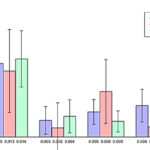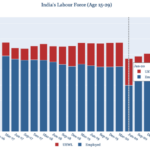Impact of the Lockdown on Incomes from Employment
1. Introduction
In an earlier note, we examined the impact of the first lockdown on employment using the PLFS data. In this note we estimate the quarter-wise non-rentier incomes of working members of households using the same dataset where the last quarter (April to June 2020) of the survey year 2019-20 coincided with the first phase of the lockdown.
While looking at the employment situation we had made a departure from the conventional WPR and UR indicators by estimating the actual WPR and actual UR by excluding persons who could not work due to the lockdown, even when their jobs notionally existed. Analysis of the data separately for the four quarters had brought out the stark effect of the lockdown. Except for the agricultural sector employing mostly rural men, most other sectors saw a drastic fall in employment. The number of individuals actually working came down by as much as 101.3 million in the last quarter from a high of 419.3 million during the second quarter of the survey. The persons reporting unemployment in Q4 (April to June 2020) rose to 82 million compared to 48.5 million in Q2 (October to December 2019).
Such a deep decline in employment has its effect on earnings from employment or the non-rentier income of the households. Here we compute the earnings from employment for all categories of workers, after making adjustments to overcome some conceptual limitations. We use the incomes from the first two quarters corresponding to April-June (which we term Q1) and July-September 2019 (Q2) as the base for comparisons.
2. Loss of households’ income
In this section we estimate the non-rentier income of working members of households in the four quarters of 2019-20. Normally, an overwhelmingly large proportion of households depend solely on non-rentier incomes of members for sustenance. (Non-rentier income excludes all property incomes received in the form of rent, interest and profit (dividends) from enterprises run by others). Also excluded are transfers in cash or kind received, such as pensions, remittances or government transfers etc. In the PLFS, information on earnings from employment are collected for all three categories of workers, viz., self-employed persons, regular wage/salaried employees and casual labourers.
Regular wage/salary earnings during the preceding calendar month are collected for only regular wage/salaried employees, while self-reported earnings from self-employment are collected for only the self-employed workers defined according to the Current Weekly Status (CWS). The wage/salary component represents the ‘compensation of employees’ earned by the household members for the labour provided by them, while self-employment earnings are the ‘mixed income’ of the households, i.e. earnings generated from their own enterprises.
The earnings data does not include the employers’ contributions paid directly to social security and pension schemes, Furthermore, property income in the form of ‘interest’ and ‘dividend’ earnings of only self-employed household members are included and not for other members of the householdsBut for a few such inclusions and exclusions in the earnings data, the earnings represent the non-rentier income of the household members and closely follow the definitions of ‘compensation of employees’ and ‘mixed income’ laid down in the 2008 System of National Accounts. In contrast, information on earnings from casual work is collected for each day of the reference week for all working members of the households.
This non-uniformity in the reference periods of earnings data for the three types of employment may affect the comparability of quarterly estimates under conditions of distress. As the data on daily wage earnings are collected for each day of the reference week for those in casual employment, we get the daily wage earnings irrespective of their Weekly Status (CWS). On the other hand, data on regular and self-employment earnings are collected for the last calendar month and the last 30 days preceding the date of survey respectively, while employment status – as defined by the CWS – is determined with a shorter reference period of 7 days. There could be infrequent cases, where a person not in self-employment according to the weekly status undertakes self-employment activity on some days. (The same may happen to those not in regular employment). Thus, a correction factor is applied for compensating for under-coverage of regular and self-employment jobs and earnings.
The correction factors are derived from the estimates of number of (full-day and half-day) jobs reported for each of the 7-days’ reference period and are meant for compensating for under-coverage of regular and self-employment jobs and earnings. The correction factor for regular employment earnings is 1 + (number of regular jobs done by those not in regular employment according to CWS) / (total number of regular jobs). For self-employment earnings, it is 1 + (number of self-employment jobs done by those not in self-employment according to CWS) / (total number of self-employment jobs). These corrections are applied separately for male and female populations of rural and urban areas. The corrections for under-coverage, however, have little effect on the final estimates, as these factors are found to be less than 1.025. The estimates presented in Table 1 are adjusted for under-estimation of population in the PLFS. Figure 1 is based on these estimates.
Figure 1
2.1 Estimates of Households’ non-rentier earnings during the four quarters
Using the estimated number of workers and average earnings, we compute the aggregate non-rentier earnings at the national level for each quarter (Table 1), correcting for population under-estimation and under-coverage of income data. The estimated average daily non-rentier earnings of the population are multiplied by the respective number of days in each quarter to arrive at the estimates presented in this table. The estimates of non-rentier earnings of all workers in 2019-20 clearly show a distinct fall in the fourth quarter. From an average of about Rs. 1,200 thousand crores in the first three quarters it came down to below Rs. 1,000 thousand crores in the fourth quarter.
The fall, as expected, was more pronounced for urban households, which account for a third of the Indian population. The closures of establishments and movement restrictions removed a significant proportion of the urban labour force from active employment during the fourth quarter. While the fall in the aggregate earnings of rural households was about Rs. 100 thousand crores, for urban households it fell by about Rs. 150 thousand crores.
Table 1: Aggregate non-rentier income of rural and urban households
(Rs 000 crores)
| Sector | Source of Earnings | Q1 | Q2 | Q3 | Q4 | Percentage Loss of Earnings | |
| Q3 | Q4 | ||||||
| Rural | Casual wage employment | 166.3 | 183.8 | 168.7 | 131.0 | -3.6 | -25.2 |
| Self-employment | 304.1 | 333.3 | 319.5 | 291.6 | 0.2 | -8.5 | |
| Regular employment | 145.2 | 145.7 | 145.8 | 130.6 | 0.2 | -10.2 | |
| Total | 615.6 | 662.9 | 633.9 | 553.2 | -0.8 | -13.5 | |
| Urban | Casual wage employment | 45.0 | 45.1 | 44.4 | 25.5 | -1.6 | -43.5 |
| Self-employment | 176.2 | 191.2 | 185.2 | 122.8 | 0.8 | -33.1 | |
| Regular employment | 329.1 | 352.3 | 351.8 | 277.1 | 3.3 | -18.7 | |
| Total | 550.4 | 588.6 | 581.4 | 425.4 | 2.1 | -25.3 | |
The decline in earnings in the fourth quarter was common to all the three types of employment. But, considering that they receive the most un-remunerative compensations for their labour, casual workers – especially in urban areas – seem to be the worst hit. Going by the weekly status, casual workers constitute a little less than a fourth of the entire workforce with one-sixth of them working in urban areas. The aggregate income from casual work in urban areas fell from Rs. 45 thousand crores in the first and second quarters to around Rs. 25 thousand crores in the fourth quarter. This could have been brought about by a fall in the number of working days and/or reduction in daily wages. But there was no sign of a fall in daily wage earnings of casual workers for any of the population groups.
Self-employed workers, with a share of well over 50% in the total workforce, were a little better off than casual workers in terms of earnings loss. They too were badly affected in the fourth quarter. However, in rural areas, with about three-fourths of the self-employed engaged in agriculture, the fall in aggregate earnings from self-employment is barely visible, while the earnings from urban self-employment suffered a loss of about Rs. 60 thousand crores. Though the self-employed in urban areas consists of workers from diverse economic classes, ranging from rickshaw pullers and street vendors to owner-proprietor of large factories and businesses, an overwhelming majority (about 95 percent) of the urban self-employed are in fact own-account workers or unpaid helpers in household enterprises. These are the ones whose earnings were badly hit by the lockdown.
The estimated total losses of earnings from the three categories of employment in Q3 and Q4, expressed as percentage loss compared to the average of the first two quarters are given in the last two columns of Table 1. The earning loss was disproportionately high for urban casual workers, followed by the urban self-employed and rural casual workers. There was a substantial loss of earnings for the regular wage/salaried workers in urban areas as well.
2.2 Monthly earning per worker from self-employment and regular employment
The estimates of average monthly earnings in Table 2 provides a comparison of monthly earnings of the self-employed and regular workers (their working status determined by their weekly status) to examine the impact of the lockdown on earnings of different categories of workers.. As explained in the earlier note, among the self-employed and regular salaried, there is a category of workers who did not work due to ‘other reasons’. This part of the workforce became quite significant due to lockdown restrictions. In Table 2, we have estimated the average earnings excluding such workers as well as after including these workers (all workers) as is customarily done.
Table 2: Average earnings (Rs.) per month of the self-employed and regular workers as per CWS
|
Population group |
Kind of worker
|
Earnings (Rs.) per month | |||
| Q1 | Q2 | Q3 |
Q4 |
||
|
Rural Men |
Self-employed actually working |
7,818 | 8,373 | 8,764 | 8,143 |
|
Regular workers actually working |
13,433 | 14,164 | 14,785 |
18,581 |
|
| All Self-employed workers | 7,658 | 8,229 | 8,340 |
7,118 |
|
|
All Regular workers |
13,217 | 13,918 | 14,021 | 13,205 | |
|
Rural women |
Self-employed actually working |
1,690 | 1,926 | 1,683 |
1,763 |
| Regular workers actually working | 11,677 | 8,770 | 10,237 |
14,699 |
|
|
All Self-employed workers |
1,659 | 1,890 | 1,631 | 1,631 | |
| All Regular workers | 11,238 | 8,493 | 9,368 |
10,003 |
|
|
Urban Men |
Self-employed actually working |
14,760 | 16,240 | 17,227 | 18,294 |
| Regular workers actually working | 18,990 | 19,665 | 22,017 |
29,021 |
|
|
All Self-employed workers |
14,248 | 15,795 | 16,010 | 11,656 | |
| All Regular workers | 18,710 | 19,391 | 21,292 |
19,801 |
|
|
Urban women |
Self-employed actually working |
4,529 | 5,332 | 5,743 | 5,862 |
| Regular workers actually working | 15,547 | 15,528 | 16,744 |
23,213 |
|
|
All Self-employed workers |
4,389 | 5,115 | 5,489 | 3,884 | |
| All Regular workers | 15,343 | 15,130 | 16,142 |
15,781 |
|
The average earnings of urban self-employed and regular workers fell substantially, with regular women workers standing out as an exception. The most revealing observation from the table is that the earnings of those actually working did not fall in Q4, but actually rose (except for actually working self-employed men in rural areas). Disregarding the possibility of a pay hike in Q4, the rise in earnings of the regular workers clearly suggests that those in less remunerative jobs were pushed out of workforce during this period. As for the self-employed workers, it appears that those running small-time businesses could not operate during Q4.
The estimates of daily earnings of regular workers across different enterprise types are shown in Table 3. Unlike the estimates in earlier tables, these are not corrected for under-coverage due to the use of weekly status. Since we are looking at four quarters of just one year, seasonal factors cannot be accounted for in the estimates. Notwithstanding this, the daily earnings of these workers seem to have dropped noticeably in the fourth quarter for all regular workers irrespective of whether they work in corporate or unincorporated enterprises.
Table 3: Earnings (Rs) per day of regular workers according to usual activity status by location and enterprise type for each quarter
|
Location and Enterprise type |
Q1 | Q2 | Q3 |
Q4 |
|
Rural – Unincorporated |
286.3 | 323.2 | 308.2 | 235.1 |
| Rural -Corporate | 520.5 | 369.8 | 392.2 |
334.6 |
|
Urban – Unincorporated |
336.7 | 372.2 | 422.1 | 289.6 |
|
Urban – Corporate |
701.5 | 672.0 | 754.9 |
632.3 |
Intriguingly, the reduction in earnings was clearly the least for the corporate sector workers in urban areas, for whom job loss was most pronounced. Thus, it seems likely that those losing corporate-sector jobs in urban areas were engaged in less remunerative jobs or with less secure contracts. Normally, the average remuneration earned by regular workers are substantially higher than that of self-employed and casual workers. Again, among the regular workers, those in the corporate sector are much better remunerated than those in other enterprises.
What emerges from the estimates discussed in this section is that the high-paid regular workers in the corporate sector were least affected by the lockdown, while an overwhelmingly large proportion of other workers engaged in non-agricultural activities had reduced earnings and some even lost their jobs. Extending the domain to include public-sector enterprises and the government, one may reasonably conclude that while households’ earnings from unorganised sector employment and casual work suffered badly, the earnings of relatively better-paid corporate-sector employees remained largely untouched during the lockdown.
3. Concluding remarks
The strict Covid control measures applied nationally and the resulting curtailment of economic activities impacted the income earning capacity of the employed.
Analysis of the data separately for the four quarters shows that the loss in terms of non-rentier income in the fourth quarter was 13.5 percent for rural households and 25.3 percent for urban households compared to the average earnings in quarter 1 and 2. The lockdown impact is also found significant for regular employees working in both corporate and unincorporated enterprises.
About the authors
Aloke Kar (alokekar@gmail.com) is currently Visiting Scientist, Indian Statistical Institute, Kolkata.
P C Mohanan (parachottilmohanan@gmail.com) is a former member of the National Statistical Commission and current Chairman, Kerala State Statistical Commission
References
- July 2021, Government Of India, National Statistical office, Annual Report Periodic Labour Force Survey (PLFS) July 2019-June 2020
- Periodic Labour Force Survey 2019-20: What does it tell us? Centre for Economic Data and Analysis, Ashoka University, 12th August 2021
- True Impact of Lockdown on Employment. Centre for Economic Data and Analysis, Ashoka University, 9 November 2021
If you wish to republish this article or use an extract or chart, please read CEDA’s republishing guidelines.








